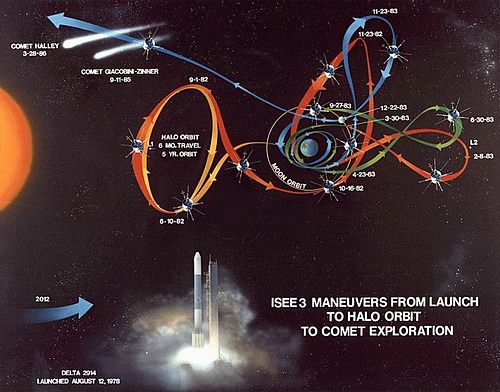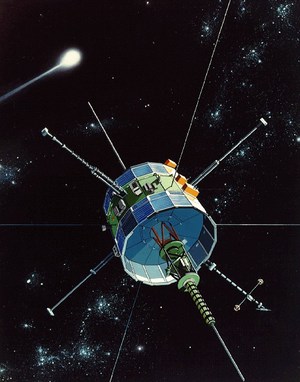The ICE mission: the first cometary encounterby Andrew J. LePage
|
| Coincidentally, the first spacecraft to have a close encounter with a comet a quarter of a century ago, called ICE, was itself a recycled spacecraft. |
Recycling an existing spacecraft that has already completed its original mission makes good sense for a number of reasons. The spacecraft has already been designed, built, and launched in the course of its original mission. These are typically the most expensive parts of any mission. For the price of a little on-board propellant needed to nudge a craft on a new trajectory and a modest amount of additional funding for mission operations and science, an existing spacecraft can sometimes be sent to another target of interest. In the case of EPOXI, that amounted to $40 million for the new mission to Hartley 2—a significantly reduced price tag compared to what a new, dedicated mission would have cost.
Deep Impact was certainly not the first spacecraft to be reused by NASA for a new mission. Coincidentally, the first spacecraft to have a close encounter with a comet a quarter of a century ago, called ICE (International Cometary Explorer), was itself a recycled spacecraft that had already completed its original mission.
The original mission
ICE started its existence as the third spacecraft in the ISEE (International Sun-Earth Explorer) program. The purpose of this cooperative program between NASA and ESA (European Space Agency) was to observe the interaction between the Earth’s magnetosphere and the Sun-dominated interplanetary environment. The first pair of satellites in the ISEE series—one supplied by NASA and the other by ESA—were launched together by a single American Delta 2914 rocket on October 22, 1977, into an elongated 340 by 137,900 kilometer (210 by 85,700 mile) Earth orbit. This pair of co-orbiting satellites, whose separation could be varied as needed, allowed observations to be made from two points inside the Earth’s magnetosphere. The American-built ISEE 3 was launched by a Delta 2914 on August 12, 1978, but instead of entering Earth orbit like its predecessors, it was placed into a halo orbit about the L1 Sun-Earth Lagrange point 1.5 million kilometers (924,000 miles) above the Earth towards the Sun—the first spacecraft to take up station there. From this unique vantage point, ISEE 3 could monitor the properties of the solar wind about an hour before it reached Earth’s magnetosphere where ISEE 1 and 2 were making their measurements. This allowed scientists to sort out if various observed phenomena were caused by the Sun or by activities in Earth’s magnetosphere.
Managed by NASA’s Goddard Space Flight Center (GSFC), ISEE 3 was a spin-stabilized spacecraft that weighed 478 kilograms (1,052 pounds) at launch. It was a cylinder 1.7 meters (5.8 feet) in diameter and 1.6 meters (5.2 feet) tall that spun at a rate of 20 rpm. Its outer surface was covered with solar cells that supplied the craft with 160 watts of power. It had two 3-meter (10-foot) booms that carried magnetometer and plasma wave sensors, and four antennae spanning 91 meters (300 feet) for radio and plasma wave studies. Sensors to determine plasma composition as well as measure protons, electrons, cosmic rays, X-rays, and gamma rays rounded out the suite of 13 instruments on ISEE 3. The spacecraft was efficiently tailored for its mission which, in concert with its sister satellites, was completed in 1981.
 A diagram of the trajectory of ISEE 3/ICE through the Earth-Moon system. (credit: NASA) |
A comet mission
In the mean time, NASA had been considering a series of proposals for a spacecraft to be sent to the most famous comet of all, 1P/Halley, during its long-anticipated swing through the inner solar system in 1986. Highly advanced and very expensive concepts involving novel propulsion methods such as solar sails and ion engines were considered, along with some more conventional approaches. In the end the expense of these proposals and the skyrocketing costs of NASA’s other programs, including the then-new Space Shuttle, combined with the cost-cutting philosophy of the Reagan Administration, would doom a dedicated NASA mission to Comet Halley. Instead, an armada of spacecraft from the Soviet Union, ESA, and Japan would make the once-in-a-lifetime trip to the famous comet without NASA.
| Going into the encounter the mission’s flight director, Robert Farquhar, put the chances of success at 50 percent. |
But there were still other options available. Since the early 1970s a team led by GSFC scientist Robert Farquhar had been studying the possibility of redirecting ISEE 3 towards a comet using a novel and fuel-saving series of maneuvers involving multiple flybys of the Moon. During the course of these long loops through the Earth-Moon system, it would also be possible for ISEE 3 to study the geotail, the largely unexplored tail of Earth’s magnetosphere. Although by the end of its primary mission the battery on ISEE 3 had died, most of its instruments were still fully functional and it even had 75 percent of its original 91-kilogram (200 pound) hydrazine propellant supply left. The probe had plenty of useful life left in it and, even though it was not equipped with cameras and dust detectors, it could make very useful measurements of the environment around a comet.
Unfortunately it would prove to be impossible to send ISEE 3 close to Comet Halley while still keeping the probe near enough to the Earth so that usable data could be received via its relatively weak 5-watt transmitter. But another mission to a closer target was identified: A mission to the short-period comet 21P/Giacobini-Zinner which would cost a very modest $3 million dollars (or about $7 million in today’s dollars). Comet Giacobini-Zinner could be reached when it was 70 million kilometers (43 million miles) from Earth which was still within reasonable communication range. By chance, ISEE 3 would also reach the comet a half a year before the international armada of spacecraft encountered Comet Halley in March 1986 so the new mission would make the world’s first comet flyby. As an added bonus, the probe could make a distant (0.21 AU, or 31 million kilometers) pass of Comet Halley while the international armada was in its vicinity, allowing some useful data to be gathered from a unique vantage point.
The new target could be reached after 18 months of long, looping orbits around the Earth-Moon system combined with 37 propulsive maneuvers and five flybys of the Moon, including a potentially dangerous close flyby of the Moon through its shadow. Because of its dead battery, ISEE 3 would have no power for 28 minutes during this final lunar encounter and there was some danger that its hydrazine propellant supply would freeze, causing a mission-ending rupture in the probe’s plumbing.
On June 10, 1982, controllers at GSFC fired the thrusters on ISEE 3 to leave the L1 point and head to its new mission in the geotail. In October NASA officially approved the subsequent mission to Comet Giacobini-Zinner and the probe was rechristened the International Cometary Explorer (ICE). On December 22, 1983 ICE, flew to within 120 kilometers (75 miles) of the Moon and survived unscathed. ICE was now on its way into interplanetary space and towards Comet Giacobini-Zinner.
The comet encounter and beyond
As ICE approached its target, there was concern that the probe would not survive the 20.6-kilometer-per-second (12.8-mile-per-second) encounter. Like any comet, Giacobini-Zinner emitted dust and, unlike a purpose-built comet probe, ICE had no protection against this hazard. Since ICE had no tape recorder and had to transmit all of its data live, a modest-sized dust strike could knock the spinning probe’s antenna out of alignment, resulting in the loss of data. It was feared that dust could coat or otherwise affect the solar panels, robbing ICE of power. In the worst case, a dust strike of sufficient size could disable the spacecraft entirely. Going into the encounter the mission’s flight director, Robert Farquhar, put the chances of success at 50 percent.
| NASA scientists are considering several options for the future of ICE, including redirecting it towards additional comet encounters in 2017 or 2018. |
In the end Giacobini-Zinner proved to be less dusty than feared and the mission was a success. ICE passed 7,862 kilometers (4,886 miles) from the nucleus of Comet Giacobini-Zinner at 9:10 GMT on September 11, 1985. Its instruments had detected the comet’s bow shock at a distance of 250,000 kilometers (155,000 miles) and directly measured the plasma tail starting at a range of about 25,000 kilometers (16,000 miles). These first in-situ measurements of a comet gave scientists the information they needed to fine-tune their models in time to tweak their plans for the upcoming encounters with Comet Halley.
After its distant encounter with Comet Halley on March 28, 1986, ICE continued making scientific observations in its independent 355-day long solar orbit in which it gradually drifted further from the Earth. Expected to return to the vicinity of Earth in 2014, when it could potentially be recovered, NASA donated ICE to the Smithsonian Institution. In 1991 NASA approved an updated heliospheric mission for ICE in coordination with ground-based observations and the ESA Ulysses probe. Because of its increasing distance, which severely limited how much data could be returned, on May 5, 1997, NASA ended the ICE mission and shut it down leaving only its transmitter carrier signal operating. In 1999 contact was briefly made with ICE to verify that it was still transmitting.
On September 18, 2008, ICE, which had finally begun drifting closer to the Earth, was located and successfully reactivated. It was found that all but one of its 13 instruments were still functioning and enough propellant remained on board for a velocity change of 150 meters per second (320 miles per hour). There appeared to be enough life left in the old probe to perform more useful science. ICE should return to the Earth-Moon system again around August 10, 2014—over three decades after it left. NASA scientists, including a team lead by Robert Farquhar, are considering several options for the future of ICE, including redirecting it towards additional comet encounters in 2017 or 2018. Still other missions are possible for this robust, reused spacecraft before it once again drifts back into interplanetary space and subsequently returns to the vicinity of the Earth sometime in the 2040s.
